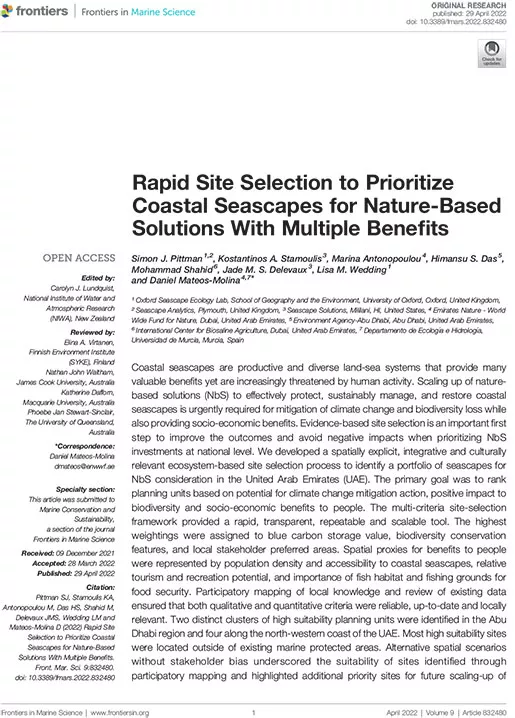Rapid Site Selection to Prioritize Coastal Seascapes for Nature-Based Solutions With Multiple Benefits
Coastal seascapes are productive and diverse land-sea systems that provide many valuable benefits yet are increasingly threatened by human activity. Scaling up of nature-based solutions (NbS) to effectively protect, sustainably manage, and restore coastal seascapes is urgently required for mitigation of climate change and biodiversity loss while also providing socio-economic benefits. Evidence-based site selection is an important first step to improve the outcomes and avoid negative impacts when prioritizing NbS investments at national level. We developed a spatially explicit, integrative and culturally relevant ecosystem-based site selection process to identify a portfolio of seascapes for NbS consideration in the United Arab Emirates (UAE). The primary goal was to rank planning units based on potential for climate change mitigation action, positive impact to biodiversity and socio-economic benefits to people. The multi-criteria site-selection framework provided a rapid, transparent, repeatable and scalable tool. The highest weightings were assigned to blue carbon storage value, biodiversity conservation features, and local stakeholder preferred areas. Spatial proxies for benefits to people were represented by population density and accessibility to coastal seascapes, relative tourism and recreation potential, and importance of fish habitat and fishing grounds for food security. Participatory mapping of local knowledge and review of existing data ensured that both qualitative and quantitative criteria were reliable, up-to-date and locally relevant. Two distinct clusters of high suitability planning units were identified in the Abu Dhabi region and four along the north-western coast of the UAE. Most high suitability sites were located outside of existing marine protected areas. Alternative spatial scenarios without stakeholder bias underscored the suitability of sites identified through participatory mapping and highlighted additional priority sites for future scaling-up of NbS. A spatial corridor of medium and high suitability planning units across the region offers potential for designing well-connected NbS investments to accelerate and boost synergistic outcomes and increase resilience. The site selection framework provides a rapid tool that integrates local and global open access data at a range of scales with great potential for transferability to other regions worldwide.
Year
2022
Publication Source
Frontiers in Marine Science
Publication type
Scientific Paper









